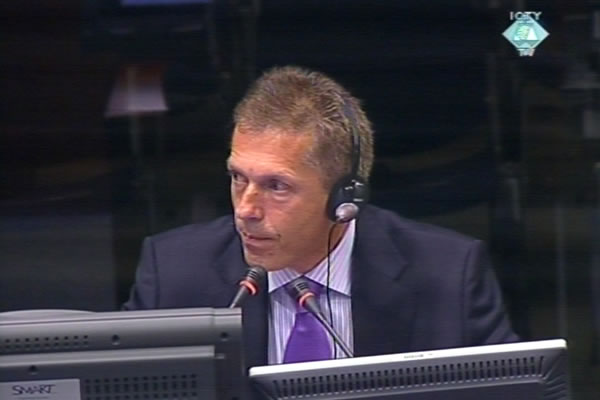Home
HORRIBLE CONDITIONS IN ‘BEAUTIFUL CENTER’ IN OMARSKA
Karadzic completed his cross-examination of protected witness KDZ 080. The trial continued with the evidence of yet another prisoner of Omarska, Mevludin Sejmenovic. He described the conditions in the prison camp as ‘horrible’; a Serbian TV journalist in a video showed in court called it a ‘beautiful center’
 Mevludin Sejmenović, witness at the Radovan Karadzic trial
Mevludin Sejmenović, witness at the Radovan Karadzic trial In the final part of his cross-examination of protected witness KDZ 080, Radovan Karadzic tried to contest her claims that Omarska prisoners who disappeared overnight from the prison camp were later killed. According to Karadzic, the fact that the witness noticed that some prisoners taken by guards from their cells never returned didn’t mean that ‘something bad happened to them’. On the contrary, the accused contends that the prisoners were taken out to be released after the investigation proved they were innocent.
The witness dismissed Karadzic’s claims and repeated what she said in the examination-in chief: each day she spent in Omarska began with counting the dead bodies scattered in the grass in front of the notorious ‘white house’. In the re-examination, the witness said that some of the victims could be identified by their clothes. As the witness said, the mass grave exhumations after the war confirmed her suspicions that prisoners who were taken out of their cells were later killed.
The next prosecution witness, former SDA official from Prijedor Mevludin Sejmenovic, spoke in more detail about the treatment of prisoners in the Omarska prison camp. ‘It was horrible. No element of behavior in that prison camp was human at all’, the witness said, adding that on their arrival in the prison, all prisoners were first beaten up. With tears in his eyes, the witness recounted the image that still haunted him: a few older prisoners carrying a 13-year old in their arms. The Serb soldiers had broken both his arms during the interrogation because he didn’t know the words of the Serb songs they made him sing.
In the examination-in chief, Sejmenovic spoke at length about the meetings he had attended before the war as the SDA deputy in the BH parliament. Sejmenovic talked about the Serb demands to divide the country into regions and about the Serb propaganda ‘conspiracy stories’ spread with the aim to instill fear of the other two ethnicities with Serbian people.
As the witness said, after the SDS seized power in Prijedor in late April 1992, Muslims and Croats were issued an ultimatum: they had to surrender several thousand weapons in 48 hours. SDS knew it was impossible because there weren’t so many weapons there. It was followed by shelling of the villages Hambarine and Kozarac in late May 1992 and the non-Serbs were expelled, massively arrested and transferred to the prison camps in Omarska, Keraterm and Trnopolje.
Prosecutor Alan Tieger showed the witness several videos. One of the videos showed the interview in which Dragan Bozanic, Serbian TV journalist, introduced the witness, who was imprisoned in Omarska at the time, as ‘an inhabitant of this beautiful center’.
Sejmenovic also described how Vojo Kupresanin, who was thee president of the Autonomous Region Krajina, rescued him from the prison camp. Kupresanin intended to appear in public with Sejmenovic as a member of the Serbian Assembly, after ‘fattening [Sejmenovic] up’. The witness was present when Kupresanin discussed it with the Republika Srpska president Karadzic. Karadzic suggested that they ‘get a suit’ for Sejmenovic and do something to make him ‘get better’.
Mevludin Sejmenovic continues his evidence tomorrow, when he will be cross-examined by Radovan Karadzic.
Linked Reports
- Case : Karadzic
- 2011-10-26 BULLET AS REWARD IN OMARSKA
- 2011-10-20 SUFFERING OF CROATS IN BRISEVO
- 2011-10-06 WITNESS: NO JUSTIFICATION FOR CRIMES IN KLJUC
- 2011-10-28 KARADZIC: SDA SECRETLY PREPARED FOR WAR AGAINST SERBS
- 2011-10-31 RADOSLAV BRDJANIN’S OFF-COLOR JOKES
- 2011-11-01 DEFENSE COUNSEL KARADZIC DEFENDS HIS CLIENT KARADZIC
